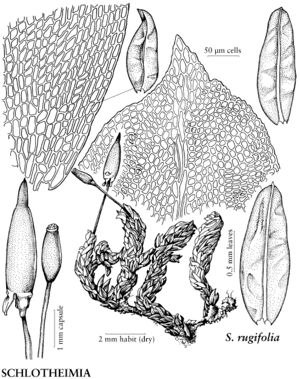Schlotheimia
Muscol. Recent., suppl. 2: 16. 1812.
| Taxon | Illustrator ⠉ | |
|---|---|---|
 | Schlotheimia rugifolia | Patricia M. Eckel |
Plants medium-sized, in dense, tomentose mats. Stems creeping, branches ascending. Leaves appressed to loosely appressed, erect, often spirally twisted around stem when dry, erect-patent when moist, narrowly lanceolate to oblong-ligulate, sometimes rugose; margins entire or sometimes serrulate at apex; apex gradually acute, acuminate, or apiculate; costa percurrent or short-excurrent; basal laminal cells elongate; distal cells irregularly quadrate to rounded-elliptic or roundedquadrate, 5–9 µm, in diagonal rows, usually smooth; marginal cells not distinct from basal. Sexual condition pseudautoicous; perichaetial leaves larger than stem-leaves. Seta 2.5–5 mm. Capsule fully exserted, rarely immersed, elliptic to cylindric, usually smooth or slightly plicate, not constricted below mouth when dry; stomata superficial; peristome double; exostome teeth 16, densely papillose-striate; endostome segments 16, sometimes rudimentary. Calyptra mitrate, long-conic to campanulate, basal lobes 4–6, smooth or papillose distally, naked or hairy, not plicate, usually covering capsule. Spores anisosporous, unicellular.
Distribution
North America, Mexico, Central America, South America, Africa, Pacific Islands (New Zealand), Australia, pantropical
Discussion
Species 100–150 (2 in the flora).
Schlotheimia is distinguished by the distinctive dark reddish coloration, habit in tree canopies and on tree trunks, and 4–6-lobed, campanulate calyptrae. The branches are stout and usually 2-fid; the basal laminal cells are porose; the seta is smooth; the exostome teeth are erect or recurved, well developed, linear-lanceolate, and often blunt; and the endostome segments are shorter than the exostome and pale. The dwarf male plants are found on the leaves of female plants.
Selected References
None.
Lower Taxa
Key
| 1 | Leaf apices gradually acute or acuminate; leaves not rugose; calyptrae smooth. | Schlotheimia lancifolia |
| 1 | Leaf apices abruptly apiculate; leaves rugose; calyptrae papillose distally. | Schlotheimia rugifolia |